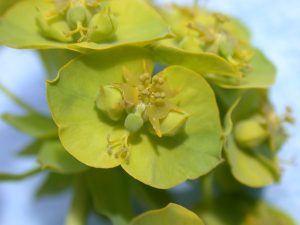Aphthona czwalinae
- Common Name: Black leafy spurge flea beetle
- Insect: Beetle, flea beetle (Coleoptera: Chrysomelidae)
- Generations Per Year: One
- Overwintering Stage: Larvae (in soil near roots)
BIOLOGY: Adults are found on plants from May through July. They vary in color from black (A. czwalinae) to copper (A. flava) with enlarged hind femurs. Females lay eggs in the ground from July to September. Eggs hatch in 16-17 days. Larvae undergo 3 instars. The larvae are small (1-5 mm long) and white with a brown head. Third instar larvae overwinter and pupate in the soil in late spring.
DESTRUCTIVE STAGE: Mature larvae (feeding on root fibers) and adults (leaf feeding)
IMPACT TO HOST: Adult feeding reduces photosynthetic capability. Larval feeding reduces the ability of leafy spurge to take in nutrients. Impact can be significant and when used with an integrated pest management strategy, leafy spurge infestations can be controlled in 5-7 years.
REDISTRIBUTION: Adults can be collected in sweep nets from May – July. Releases should be made on small thin stands of leafy spurge or on the edge of a large infestation. Ant predation can be a problem in establishing this biological control. If this agent fails to establish after one year, purchase pure collections commercially and treat your release site for ants in the fall before releasing biological control agents the following spring.


